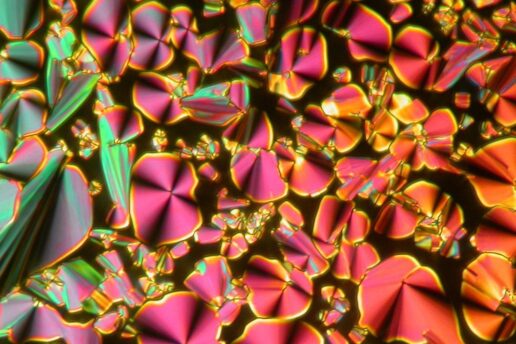
Finding the Magic in Liquid Crystals
The uncanny material in your TV display may hold astonishing potential for creating future technologies.
The most glamorous fields in physics are probably cosmology and the search for new fundamental laws. While those subjects are glorious, there’s also another frontier to relish: the pursuit of magic. Of course, here I don’t mean trickery but magic in the spirit of the science-fiction writer Arthur C. Clarke’s famous law: “Any sufficiently advanced technology is indistinguishable from magic.”
This kind of magic happens when we learn new ways to control the physical world. Many technologies that would have seemed utterly magical a hundred years ago—including nuclear energy, magnetic resonance imaging and GPS—have bubbled up from the quantum world.
But there’s another branch of modern magic, under-appreciated and still vastly underdeveloped, that has humbler origins. You can see a hint of it in the gooey residue left behind in your soap-dish. Elementary science classes advertise three “states of matter”—solid, liquid and gas—but that barely scratches the surface of what’s out there. That goo is something else: a liquid crystal.
Liquid crystals, which flow like liquids but interact with light like crystal, are a distinct phase of matter. They are usually made from long organic molecules. Their basic secret is that those molecules are oriented in regular patterns, while their centers can move freely. The oriented molecules act like little antennas for the electromagnetic waves we see as light. They absorb those waves and then retransmit them in altered forms.
Because liquid crystals combine light-altering properties with fluidity, they can provide ultra-flexible, color-sensitive lenses and polarizers. This makes them tremendously useful for building visual displays. Indeed, liquid crystals are central players in most modern computer screens.
The mathematical theory of liquid crystals combines the intricate symmetry of crystalline patterns with the dynamical richness of liquid flows and then examines how these elements interact with light. In 1991, Pierre-Gilles de Gennes won the Nobel Prize in Physics for his contributions to that theory.
Yet when it comes to our understanding of liquid crystals, the best is yet to come. In fact, liquid crystals are central to life itself. A special kind of two-dimensional liquid crystal, closed up into sphere-like surfaces, forms the membranes that define the boundaries of cells and of functional units within cells. These crystals can selectively dissolve complex protein molecules, thus accommodating cellular eating, digestion, excretion and respiration. They can also grow, bud and fission—activities that are the soul of biological development and reproduction.
Human engineers haven’t caught up to nature’s skill in this medium. Our machines don’t reproduce, develop, heal or regulate intercourse with their environment with anything approaching the sophistication of biology. A major bottleneck is that although we have good equations for liquid crystals, we’re not yet good at using those equations to guide creative design.
This problem may be too complicated for unaided human brains. It seems likely that computer algorithms, which learn by doing (or, more accurately, by simulating), will yield more successful designs than conventional human logic. In this way, today’s magic will conjure up tomorrow’s.
Originally appeared on August 8, 2019 on The Wall Street Journal website as ‘Finding the Magic in Liquid Crystals‘
Frank Wilczek is the Herman Feshbach Professor of Physics at MIT, winner of the 2004 Nobel Prize in Physics, and author of the books Fundamentals: Ten Keys to Reality (2021), A Beautiful Question: Finding Nature’s Deep Design (2015), and The Lightness of Being: Mass, Ether, and the Unification of Forces (2009).